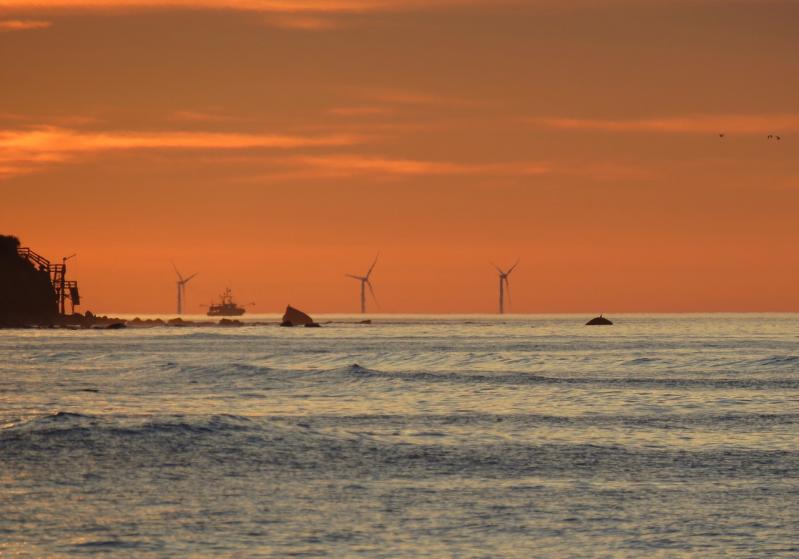Change is hard but essential if East Hampton Town and the wider world are going to mitigate and adapt to the impacts of climate change, officials of the Nature Conservancy said this week in the wake of the United States government’s Fifth National Climate Assessment, issued last week.
Coastal retreat is inevitable, said Alison Branco, the Nature Conservancy’s director of climate adaptation, and people will have to become accustomed to seeing energy-generation sites, said Jess Ottney, the group’s New York director of policy and strategy, though those sites will be solar and wind farms rather than fossil-fuel power plants.
The Fifth National Climate Assessment, conducted by more than 500 experts including five scientists from the Nature Conservancy, includes both grim assessments (“current adaptation efforts and investments are insufficient to reduce today’s climate-related risks and keep pace with future changes in the climate”) and hopeful signs (“large near-term cuts in greenhouse-gas emissions are achievable through many currently available and cost-effective mitigation options”).
Here in the Northeast, climate change is damaging infrastructure through extreme weather events and shifting distributions of coastal and marine species and habitats, according to the assessment. Increasing water temperatures, invasive aquatic species, and ocean acidification and deoxygenation put fisheries at risk. More frequent and intense precipitation is already evident on the South Fork, and agriculture is especially vulnerable to runoff and flooding, which causes further environmental degradation by transporting debris and contaminants that cause harmful algal blooms and pollute drinking water.
Sea level rise and saltwater intrusion endanger groundwater aquifers and stress aquatic ecosystems. Sea-level rise also threatens permanent inundation of infrastructure, the assessment notes.
“The good news is we’re starting to make progress,” Ms. Branco said. “That’s certainly true in New York and on Long Island. But a lot of what we’ve been doing is the low-hanging fruit, the easier things. If we really want to address these enormous problems, we have to do something bigger and more transformative. It has been recognized, especially on Long Island, because it is impacted so much by flooding and extreme weather.”
East Hampton “has been doing a great job of not just working on mitigation but also adaptation,” she said, pointing to the Coastal Assessment and Resiliency Plan, or CARP, which was adopted into the comprehensive plan last year. “Since that was completed, they’ve been trying to apply for grants to implement, and taking next steps in planning, working on a lot of zoning updates.”
She pointed to the $350,000 federal grant awarded a year ago to explore “living shoreline” projects on Fort Pond and Lake Montauk. “Not a bad project, but the type that buys you a little more time. It doesn’t really transform the way we live with the water. More transformative would be, whatever is threatened, moving it from the shoreline, making way for all that water.”
“The fact is we’re looking at up to six feet of sea level rise by century’s end,” Ms. Branco continued. “We really need to take seriously those projections, and in the way we live with our shoreline. On the East End in particular, where it’s very narrow, we need to remember, it’s not just rising water that’s a problem; of course it is, but as sea level is rising, it’s manifesting in erosion of our beaches.” In the natural world, she said, the beach would naturally migrate inland, “but it can’t because we’ve put houses and roads in its way. If we want a beach long into the future, we need to make some room for those natural processes to happen. Or else, we’ll have a bunch of hotels — or stores or restaurants — with no customers because there’s no beach.”
The Nature Conservancy and Defenders of Wildlife led development of the Long Island Solar Roadmap, Ms. Ottney said. “One of the things we’re seeing happening in town halls across the state is a lot of local concern and resistance to renewable-energy development.” Examples on the South Fork include opposition in East Hampton to the South Fork Wind farm and, in Southampton Town, to a proposed battery energy storage system in Hampton Bays. “Of course, any kind of development comes with a lot of questions, and those are valid, but we’re seeing a lot of projects held up and scrutinized much more than your average subdivision or self-storage or commercial strip mall. . . . We do need to build more clean energy in order to power our homes and vehicles and businesses so that we do not experience the impacts that this recent National Climate Assessment is saying all Americans are now experiencing. If we’re going to get to a place where sea-level rise or flooding is not as severe and inundating our neighborhoods every time there is a storm . . . we need to make sure we’re taking action.”
Communities will have to support renewable-energy siting within the community, Ms. Ottney said, and the Long Island Solar Roadmap is one way to site installations “in a way that does not require making unnecessary tradeoffs,” she said. Solar energy generation can be developed on agricultural land, a practice known as agrivoltaics, which “allows for continued cultivation or grazing on that property.” In historic districts, solar installations can be shielded by buffers to protect vistas or “viewsheds,” she said. Solar canopies can be sited in parking lots, which is planned for the town’s new senior citizens center, to be constructed in Amagansett. “For a long time, only some of us have been seeing our energy production,” Ms. Ottney said. “Very few people live near power plants. Going forward, more people will see energy production. The good news is, it will be clean.”
Ms. Branco predicted “a real push toward green energy” on Long Island in the next several years, including solar and wind power. The State’s Climate Leadership and Community Protection Act, signed in 2019, mandates greenhouse-gas reductions of 40 percent below 1990 levels by 2030 and 85 percent below 1990 levels by 2050. “We really need to meet those, and that takes all of us,” she said. “We’re the ones with the ocean, so we’ve got all the wind. We’re not used to seeing the source of our energy generation, and will have to get used to seeing that. . . . It’s important for Long Islanders to get behind the need and support that, rather than fight against it.”
Along with reducing their own carbon footprint, South Fork residents should consider “who we vote for and what they’re doing for the climate,” Ms. Branco said. “As much as the report is full of bad news, it also gives some hope, because it’s showing we’re starting to move the ball in the right direction. More and more people are taking action. We have really good science to tell us what we need to do. Now we need to rally the people to do it.”




